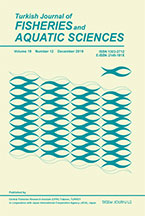Aquaculture Studies
2021, Vol 21, Num, 2 (Pages: 63-73)
Effects of Feeding Strategies on Growth Performance and Economic Returns on the Production of Nile Tilapia (Oreochromis niloticus) in Fertilized Ponds
2 Aquafish Innovation Lab, Oregon State University, USA DOI : 10.4194/2618-6381-v21_2_03 Viewed : 2750 - Downloaded : 3080 This study evaluated the effects of restrictive feeding strategies on the profitability of tilapia production in fertilized ponds. Sex-reversed tilapia fingerlings (~60g) were cultured for five months under three feeding strategies; alternate-day full ration (100%), 66.7% and 75% of full ration daily. Fish fed 75% of the full ration daily had the highest final weight (411.3±39.32 g), followed by fish fed 66.7% of the full ration daily (352.0±9.17 g) and the fish fed alternate-day full ration (227.8±22.17 g). Fish that received the alternate-day full ration had the lowest feed intake (223.8±29.77 g fish-1) and a better feed conversion ratio (1.30±0.12) compared to the fish fed 66.7% (1.51±0.12) and 75% (1.52±0.09) of full ration daily. Crude protein, dry matter, ash content and the hepatosomatic index of the fish were not affected by the feed restriction. The crude lipid, mesenteric fat and the viscerosomatic indices were significantly (P<0.05) lower in fish that received the alternate-day full ration. While the cost of production was lowest in the alternate-day ration, it had the lowest economic returns (US$ 82.95±8.60) compared to fish that received 66.7% and 75% of full ration daily (131.16±22.62 and 162.48±19.64 US$, respectively). These results indicated that tilapia can be cultured in fertilized ponds and fed with two-thirds of daily full ration given in intensive systems without any effect on economic returns. Keywords : Feeding strategy Feed restriction Growth performance Tilapia pond culture Profitability















